
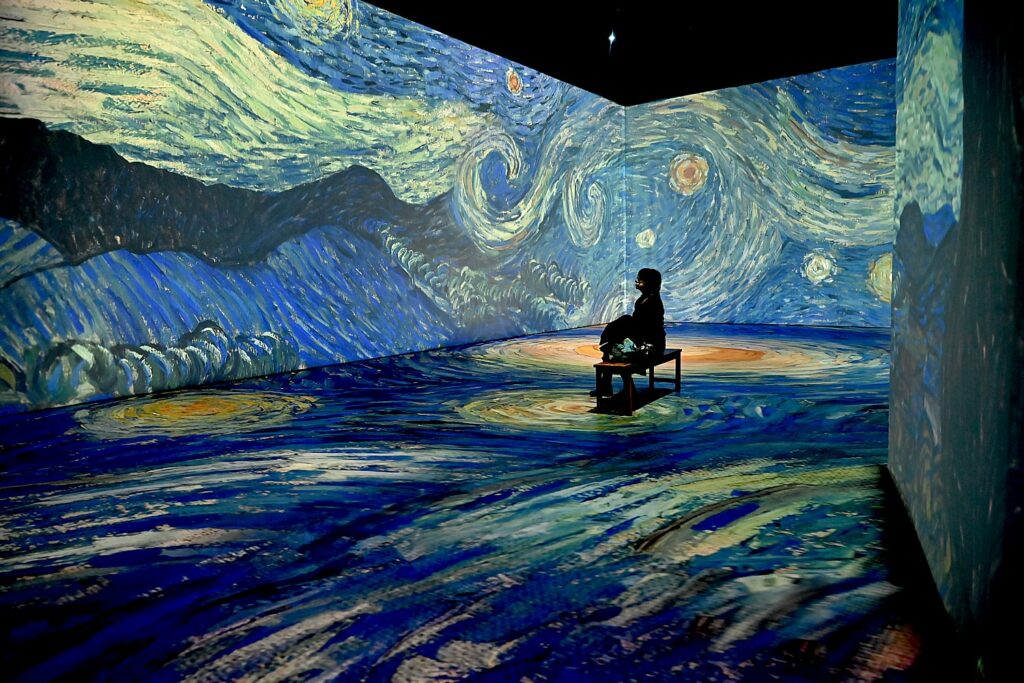
By Karen Rubin, Travel Features Syndicate, www.goingplacesfarandnear.com
What the leading edge technology of Beyond Van Gogh: The Immersive Experience does is to turn a static, albeit emotional, experience of appreciating a painting, into an active, dynamic, cinematic one.
On view at Samanea New York Mall, Westbury, Long Island only until January 2, in the course of 40-minutes, you see some 300 of Van Gogh’s paintings surrounding you, projected on all four walls and the floor in a 30,000 sq. ft. space the size of a basketball court. The paintings fill the entire wall, large enough to walk into, become animated, turning stills into images that grow, change, emerge, ripple, wave, flow and blossom over you – in essence, animating the movement that Van Gogh so powerfully created with his paint strokes.
It is as if you see the painting develop from Van Gogh’s perspective and hand.
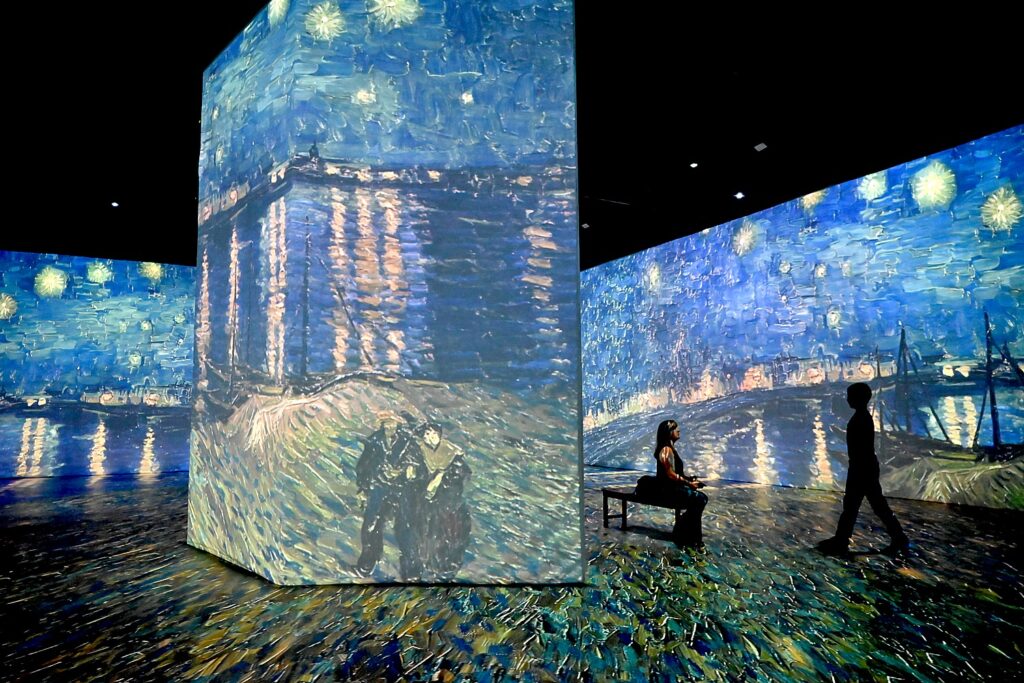
And I have to say, it is more stirring to see his works this way, than when I have seen “Starry Night Over the Rhone” which attracted the biggest crowds in a room in the Musée d’Orsay in Paris, or “Sunflowers” at the Museum of Modern Art, or his famous self-portrait at the Metropolitan Museum of Art. Is it blasphemous to say that these manifestations are more emotionally captivating than the original? Or is it enough to say, the paintings presented this way are as emotionally captivating but in a different way that adds cinematic drama.
The other benefit is that you see in this incredible 40-minute presentation some 300 of Van Gogh’s paintings – and not just zipping in front of your eyes, but well paced, magnificently and respectfully presented, each scene staying long enough to absorb what you are seeing all around you, to music perfectly curated to convey mood and emotion, before changing again.
It begs for active engagement in the sense of walking around, changing your visual perspective, even as the scene changes. There is a sense of immediacy as well as immersion.
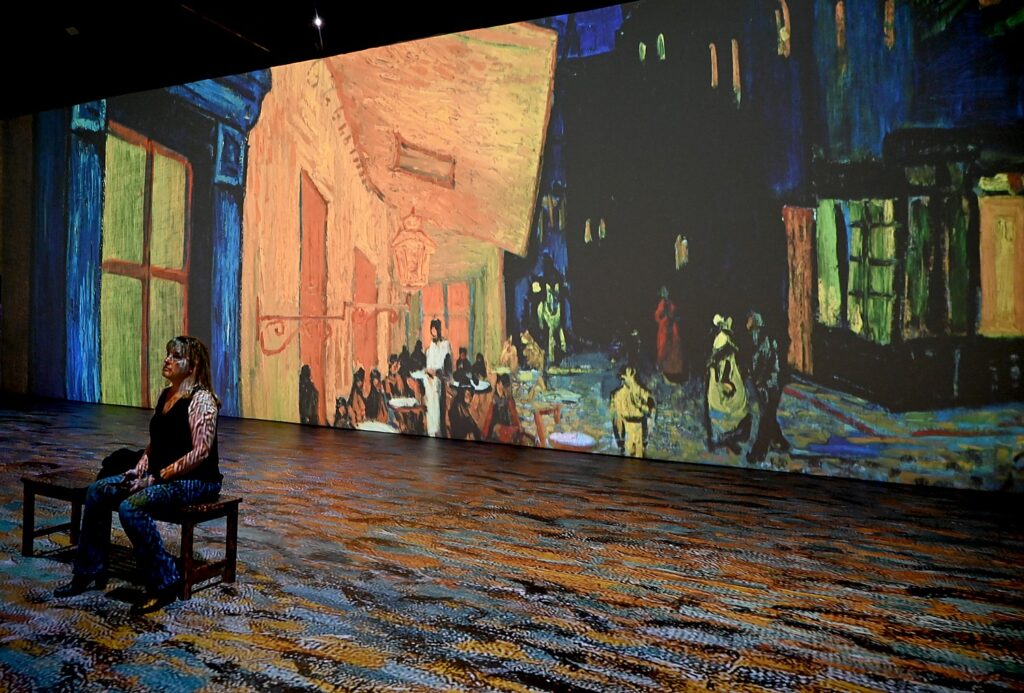
Timed tickets, the vast openness of the space and enormous scale of the paintings almost ensure you will have enough space to feel yourself a part of the paintings, large enough as if you could walk into any scene.
The music that provides the backdrop for the different scenes and themes of the works presented are equally well curated.
You are in tune with Vincent, as well, because the paintings seem to originate as if from his own hand – the basis are these sensitive quotes that mostly come from the letters between Vincent and his loving brother Theo, which document how he came to his artistic expression.
“the heart of man is very much like the sea, it has its storms, it has its tides and in its depths, it has its pearls too,” he wrote Theo from Isleworth in 1876.
“…in all of nature, in trees for instance, I see expression and a soul, as it were,” Vincent writes Theo in 1882.
“I don’t know if you’ll understand that one can speak poetry just by arranging colours well, just as one can say comforting things in music,” he writes his sister Willemien from Arles, in 1888.
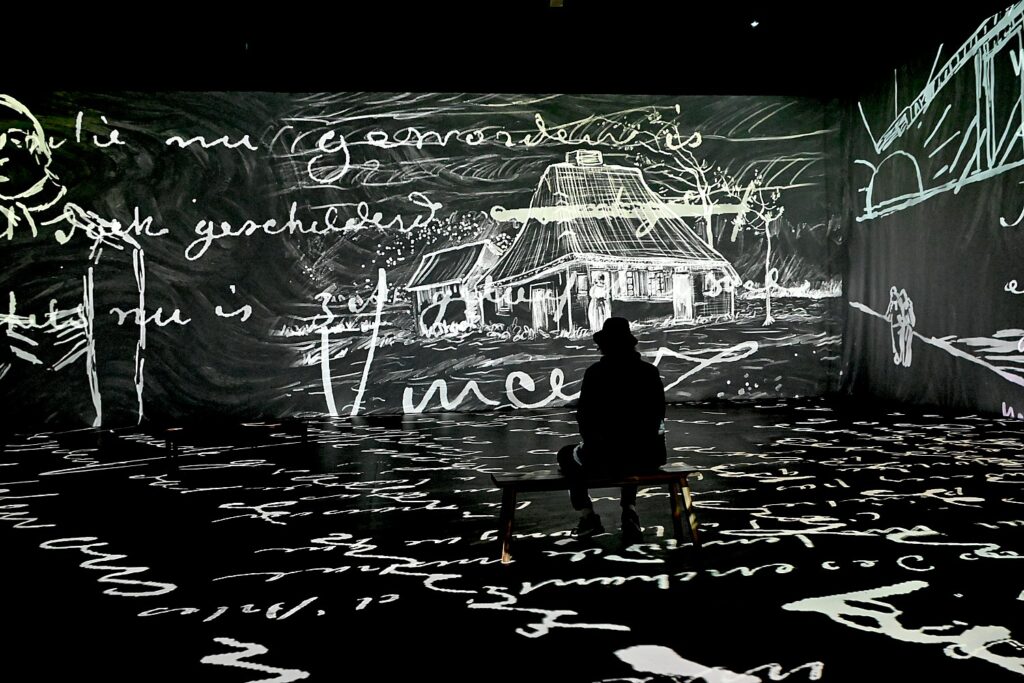
Van Gogh’s biography is very much abbreviated – the focus is on his art and creativity. But there are these important nuggets that provide a context for better appreciating the paintings, that come from revealing quotes from the letters between Vincent and his loving, supportive brother Theo, which document how he came to his artistic expression and what art, color, light, nature meant to him. I had no idea he came so late to being an artist, beginning when he was 27, in fact, the vast majority of his 1000 canvases, painted in only a decade, were painted in the last three years of his life, or that he became an art dealer like his brother, Theo, then, briefly studied to become a preacher, before devoting himself to his art.
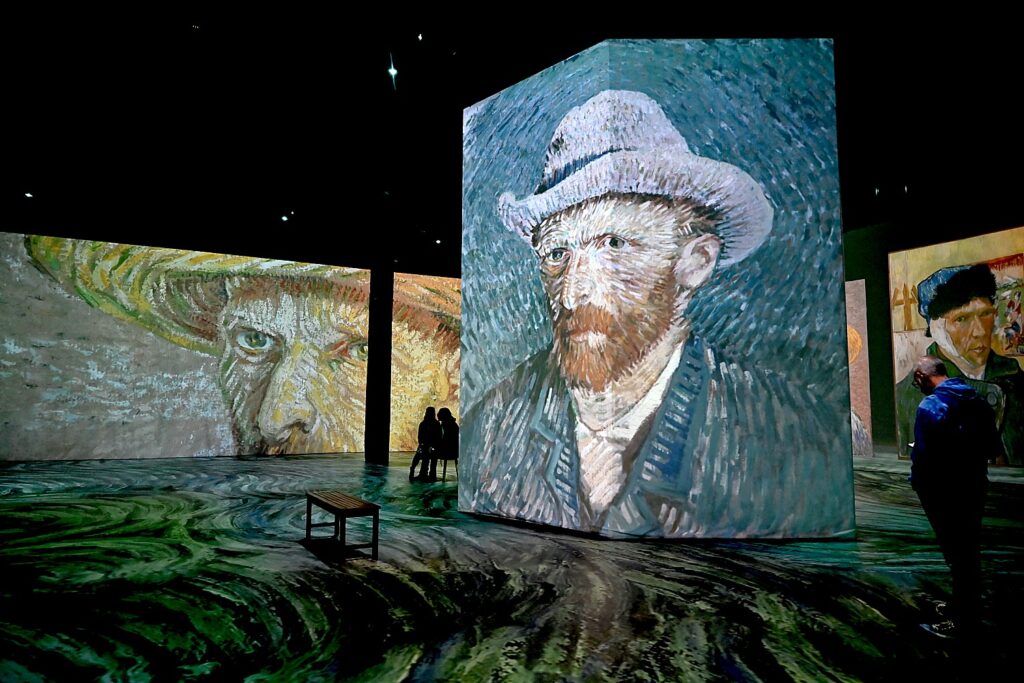
But it is intensely personal – throughout the exhibit, you see and hear snippets of Van Gogh’s letters to his brother, Theo, that provide such insights into Van Gogh’s essence, and burst the monotone myth of a man in a constant state of anguish: “the heart of man is very much like the sea, it has its storms, it has its tides and in its depths, it has its pearls too,” he wrote Theo from Isleworth in 1876.
“In life and in painting too,” he writes Theo in 1888 from Arles, “I can easily do without the dear Lord, but I can’t, suffering as I do, do without something greater than myself, which is my life, the power to create.”
Paintings emerge like brush strokes, or like ripples of hot air, or like waves that wash over the canvas, splashing across the floor.
Sometimes the paintings themselves are made to animate, like the smoke that rises from the pipe he smokes in a self-portrait; and a windmill’s fans actually turn (a game for the viewer, a device to engage).
The scenes unfold, linger long enough to be appreciated, then another scene emerges.
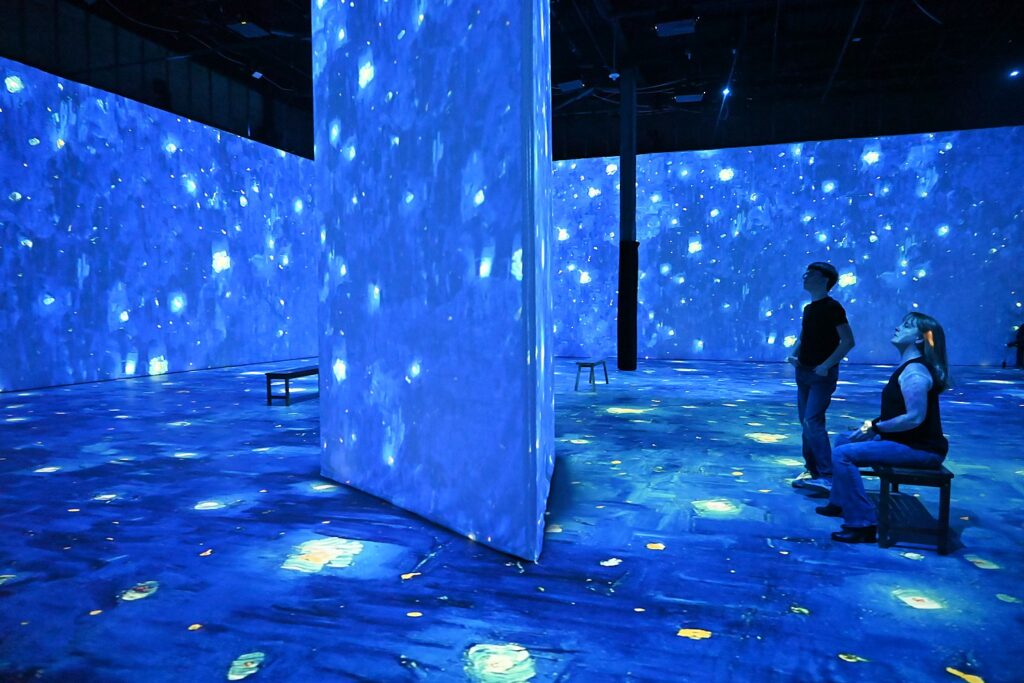
It is stunning to see his famous “Starry Night Over the Rhone” (1888) take over the walls and splash over the floor, the reflections of light in the water not at all static but shimmering, glittering and rippling.
“..the sight of the stars always makes me dream…” Vincent writes Theo from Arles in 1888.
In another scene, trees grow up with springtime blossoms multiply, blow in the wind, gathering more and more, becoming a storm of petals. You hear the wind.
Another display imagines a score of canvases stacked up against the wall – then transmute to stilllifes.
A roomful of the portraits he painted is profound – going beyond their surface image to create these characters.
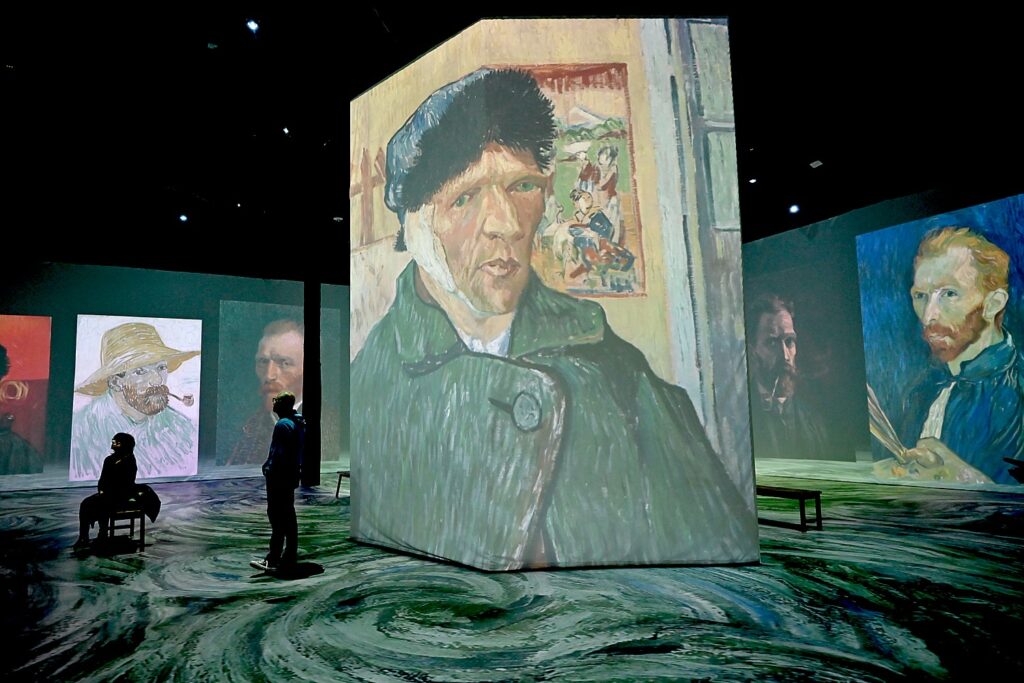
When a whole roomful of his self-portraits unfold, you are struck by the honesty. “It is difficult to know oneself, but it isn’t easy to paint oneself either,” he writes from Saint-Remy in 1889
Van Gogh didn’t sell any of his art during his lifetime. He suffered from clinical depression that in those days, had no medical treatment. But he seemed to have a desperate desire and even an inclination that his works would survive him, as when he refers to his subjects as becoming “ghosts” visiting future viewers.
An artist who today is considered one of the greatest of all time was considered a failure (as an artist). In this, Van Gogh gives hope and inspiration to every other failed, un- and under-appreciated artist.
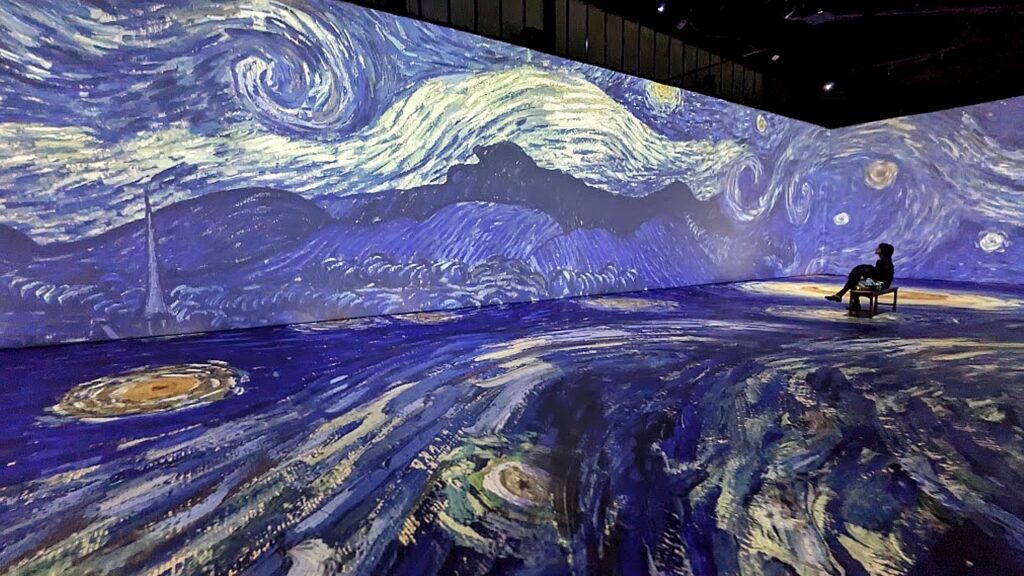
The show, brilliantly, sensitively, imaginatively done, is itself a work of art – multi-media, performance art – because it takes all of these works and creates something new, a new way to experience the paintings, that will engage young people being introduced to art as well as devotees, artists and academics.
“I came to recognize and appreciate that the world was witnessing the cusp of a new art form- a reinterpretation of the fascinating narrative between master and masterpiece,” writes Gilles Paquin, Founder, Chairman, Executive Producer of Paquin Entertainment Group, Inc., in the forward to the show’s publication. “Combining fine art and artifacts with music and cinema, curated, staged and presented in a way that can be enjoyed by an audience so diverse it transcends the confines of age, gender and cultural demographics.”
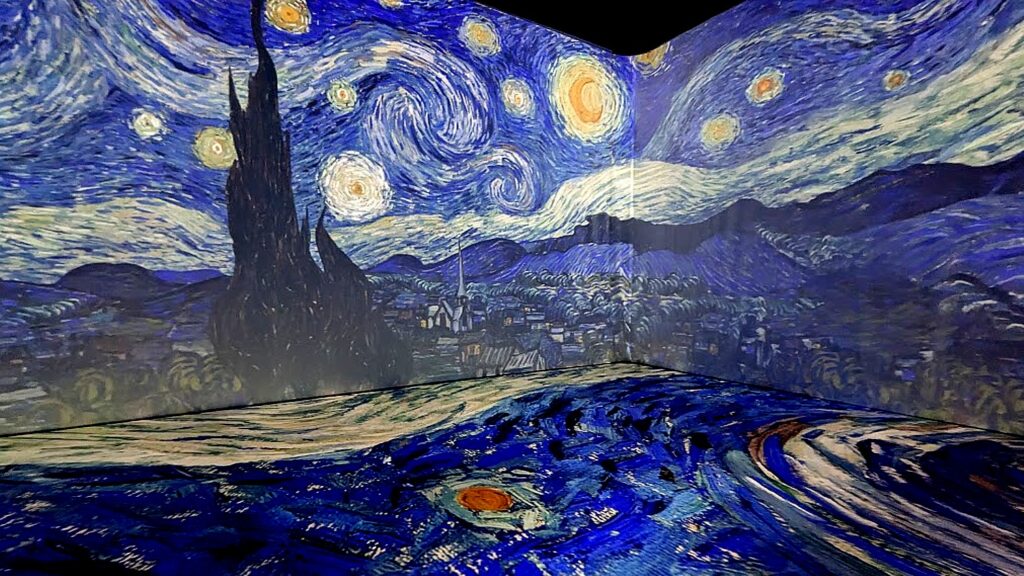
“At the start of this creation, we searched for a refreshing perspective of Van Gogh’s vision of the world,” writes Mathieu St-Arnaud, Creative Director & Art Direction, Normal Studio. “What we found was unexpected and captivating: we were met with Vincent, a human being like all of us, an artist devoted to his craft, yearning for beauty and moved by purpose. It became a personal journey for us, one that we wanted to extend to audience members around the world: to go beyond the myth that is Van Gogh and instead meet Vincent, the man behind the vision. Wielding colour and light, Vincent transformed hardship and darkness into light and joy, infusing his work with a contagious sense of hope that it still exudes today. Amidst the challenges of today, there’s something truly inspiring in Vincent’s will to focus on the wonders of the world and his determination to both capture and share them with all of us. In more ways than one. Vincent is the artist we need right now.”
The end of the loop is a series of Vincent’s famous signature that emerge from scores of his paintings – we learn that he only signed “Vincent” because he feared his surname would be too difficult to pronounce. “yours very truly, Vincent.”
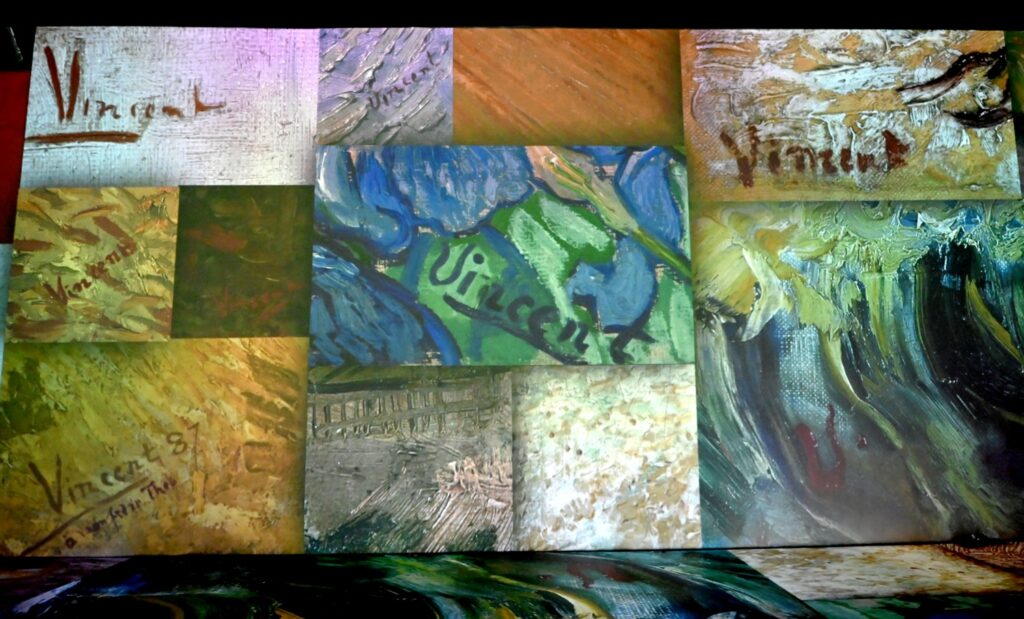
This scene is like Van Gogh’s final word as if to say, “This is me. This is what I created. This is what I have left to the world.”
Vincent Van Gogh left this world in 1890, 37 years old, just as his work was gaining critical recognition. “to succeed, to have lasting prosperity, one must have temperament different from mine,” he writes Theo in 1889. “I make a point of telling myself, yes I am something, I can do something.”
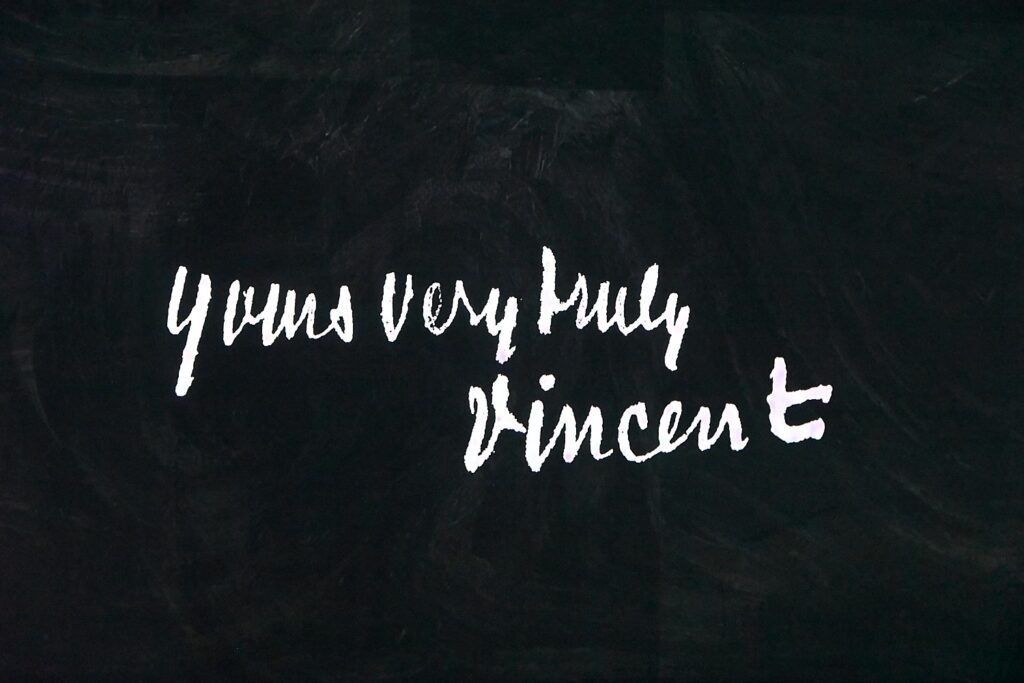
Beyond Monet: The Immersive Experience
Long Islanders are lucky because Beyond Van Gogh: The Immersive Experience which was brought back after a hugely successful run through the holidays, alternates days with Beyond Monet: The Immersive Experience.
Beyond Monet: The Immersive Experience gives guests a glimpse into the emotions and perspectives of the leading figure of Impressionism: Claude Monet, with some 400 of his works. Taking inspiration from Musée de l’Orangerie in Paris, the designated home of Monet’s masterpieces, guests can freely roam the Infinity Room to absorb the artist’s bright and colorful paintings. Monet’s stunning imagery encompasses every surface of the room, transporting guests inside the paintings themselves. It is a haven for awakening the senses as the ebb and flow of the artwork is accompanied by the rhythm of an original score.
“When you stand inside Beyond Monet, you truly feel like you are part of Monet’s passionate quest for the effervescent beauty of the world,” Beyond Monet Art Historian Fanny Curtat said. “Experiences like these create fresh and original perspectives, allowing us to form new relationships with notable masterpieces in dynamic and fascinating ways.”
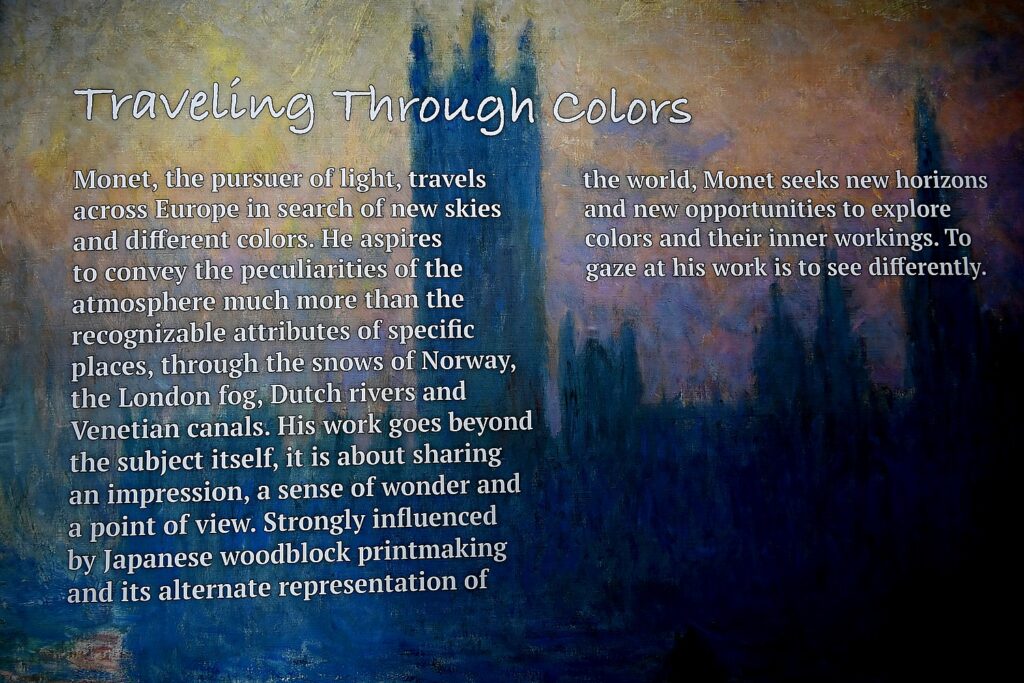
“Through cutting edge technology, Beyond Monet: The Immersive Experience is redefining what art means to people,” stated Paquin Entertainment Group’s President of Exhibitions and Theatrical, Justin Paquin “It has elevated artwork to the next level, allowing us to form new relationships with notable masterpieces that were just not possible in previous years.”
See schedule and purchase timed tickets to Beyond Van Gogh: The Immersive Experience in advance at www.vangoghlongisland.com (on Wednesdays and Fridays) alternating with alternating with Beyond Monet The Immersive Experience at www.monetlongisland.com (on Thursdays, Saturdays and Sundays), at Samanea New York, 1500 Old Country Road, Westbury, NY.
____________________________
© 2023 Travel Features Syndicate, a division of Workstyles, Inc. All rights reserved. Visit goingplacesfarandnear.com, www.huffingtonpost.com/author/karen-rubin, and travelwritersmagazine.com/TravelFeaturesSyndicate/. Blogging at goingplacesnearandfar.wordpress.com and moralcompasstravel.info. Visit instagram.com/going_places_far_and_near and instagram.com/bigbackpacktraveler/ Send comments or questions to FamTravLtr@aol.com. Tweet @TravelFeatures. ‘Like’ us at facebook.com/KarenBRubin






